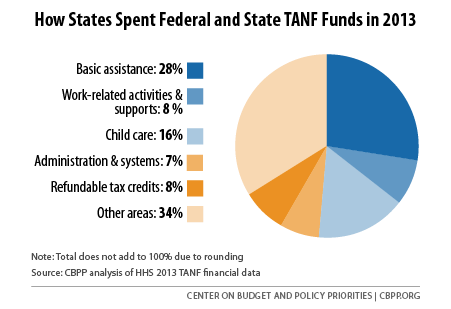BEYOND THE NUMBERS
Proponents of block-granting key safety net programs like Medicaid and SNAP, as the House budget plan would do, often cite Temporary Assistance for Needy Families (TANF) as a model. But, as our new paper explains, a close look at how states have used TANF’s funds since its creation under the 1996 welfare law provides a cautionary tale about the dangers of block-granting these programs and giving states extensive flexibility on using the funds. The cash assistance safety net for the nation’s poorest families with children has weakened significantly under the TANF block grant.
Beginning in TANF’s early years, when the economy was strong, shrinking cash assistance caseloads freed up federal and state funds that had gone to poor families in the form of benefits. States used the flexibility of the block grant to redirect those funds.
Some of the freed-up funds initially went to child care and welfare-to-work programs to further welfare reform efforts. But over time, states redirected much of their state and federal TANF funds to other purposes, in some cases to replace state spending on other priorities. And when need increased during the Great Recession, states often did not direct the funds back to core welfare reform services and instead made cuts in basic assistance, child care, and work programs.
Our examination of state spending data for 2013 found:
- The share of state and federal TANF spending used for basic assistance (cash welfare grants) has fallen significantly. At TANF’s onset, 70 percent of combined federal and state TANF funds went for basic assistance for poor families. By 2013, that figure had plummeted to 28 percent.
- States spend only about a quarter of their state and federal TANF dollars on child care and work activities combined. A key justification for block-granting TANF was to give states flexibility to move funding from cash assistance to work-related activities and/or supports (such as child care subsidies). States raised spending in these areas in TANF’s early years but didn’t sustain those modest increases.
- Core welfare reform activities thus represent roughly half of state and federal TANF spending. Child care, work activities, and basic assistance combined totaled 51 percent of federal and state TANF spending nationally in 2013 (see graph).
- States use a large and growing share of state and federal TANF funds that formerly helped poor families meet basic needs for other state services. In some cases, states have used TANF funds to expand programs, such as state Earned Income Tax Credits (EITCs) or pre-K, or to cover the growing costs of existing services, such as child welfare. In other cases, they have used TANF funds to replace existing state funds, thereby freeing those state funds for purposes unrelated to a safety net or work opportunities for low-income families.

